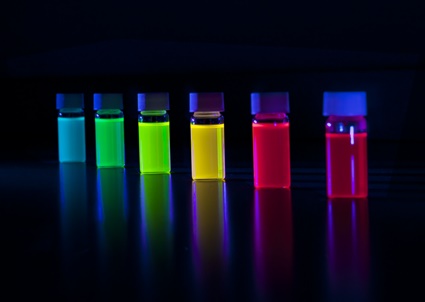How are Quantum Dots Made?
Nanoparticles are determined by their size and geometry. By definition, they must be below 100 nanometers (nm) to qualify as a nanoparticle, and that miniscule scale is integral for determining the mechanical properties of the material. Transparent or crystalline particles of nanomolecular dimensions can emit monochromatic light of wavelengths specific to their dimensions. Quantum dots, for example, attenuate photons of light when excited by a light source. This creates conduction bands within the nanoparticle. When excited electrons fall back to the outer orbit of the atom from this conductive orbit, they emit light – the wavelength of which is decided by the atomic distance between the conductive band and the outer orbit.
This fluorescent behavior is enabled by the fact that quantum dots exhibit similar mechanical properties to that of atoms. Quantum dots of multiple sizes are typically included in samples or dispersions, enabling products to utilize or display the entire wavelength spectrum.

But how are quantum dots made? This article will explore some of the common processes of formulating nanocrystals:
Colloidal Synthesis of Quantum Dots
Colloidal synthesis is one of the most cost-effective methods for synthesizing quantum dots. This solution-based chemical process involves heating precursor solutions to form nucleated monomers, which anneal under high temperatures and result in nanocrystal growth. The volume and size of quantum dots produced through colloidal synthesis is controlled by regulating the concentration of monomers in the solution and maintaining precise temperature conditions throughout the process.
Plasma Synthesis of Quantum Dots
Plasma synthesis has been used to formulate powder-based quantum dots, through nonthermal gas-phase processes. This novel approach to producing nanocrystals, which conventionally use high-temperature synthesis methods, relies instead upon energetic surface reactions. There is evidence to suggest that plasma synthesis of nanoparticles could improve doping processes for quantum dots, enabling further functionalities.
Quantum dots manufactured using either of these methods are conventionally composed of metallic compounds, including:
- Cadmium selenide (CdSe);
- Indium phosphide (InP).
While the use of Cadmium in electronics is regulated by RoHS, InP is on a priority list to be regulated in the near future. Avantama have developed superior quantum dots using Perovskite quantum dots, which are fully RoHS compliant and exhibit improved optical properties over current market-standard materials. Avantama has developed a novel process yielding the best performing quantum dots at industrial scale.
Quantum Dots from Avantama
Avantama is a leading developer and supplier of cutting-edge nanoparticles and solutions for numerous industrial sectors. We are committed to providing the most mechanically stable quantum dots and improving the production processes of emerging materials, to ensure industry standards are consistently safe and sustainable.
If you would like any more information about our cadmium-free quantum dots, please do not hesitate to contact us.